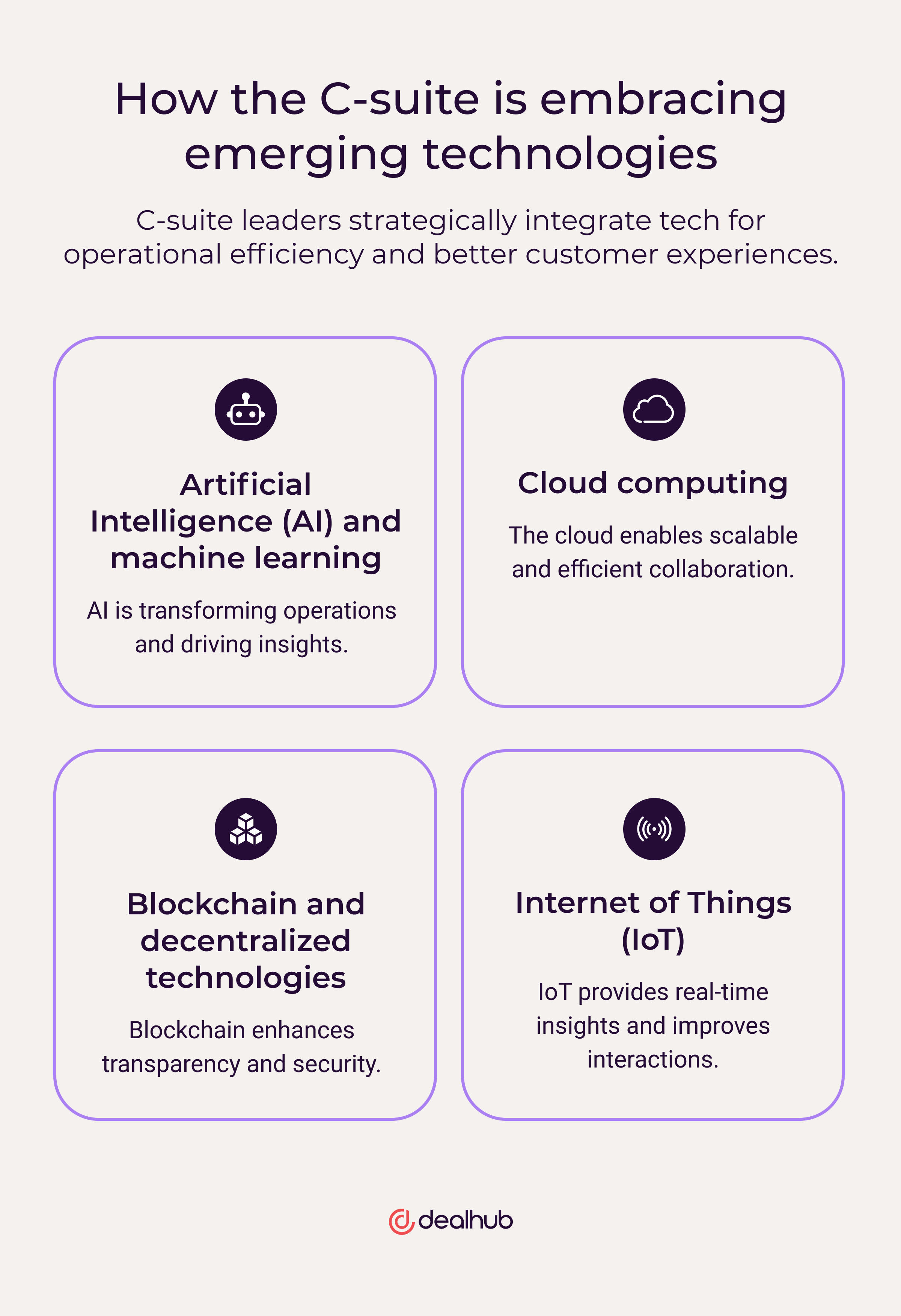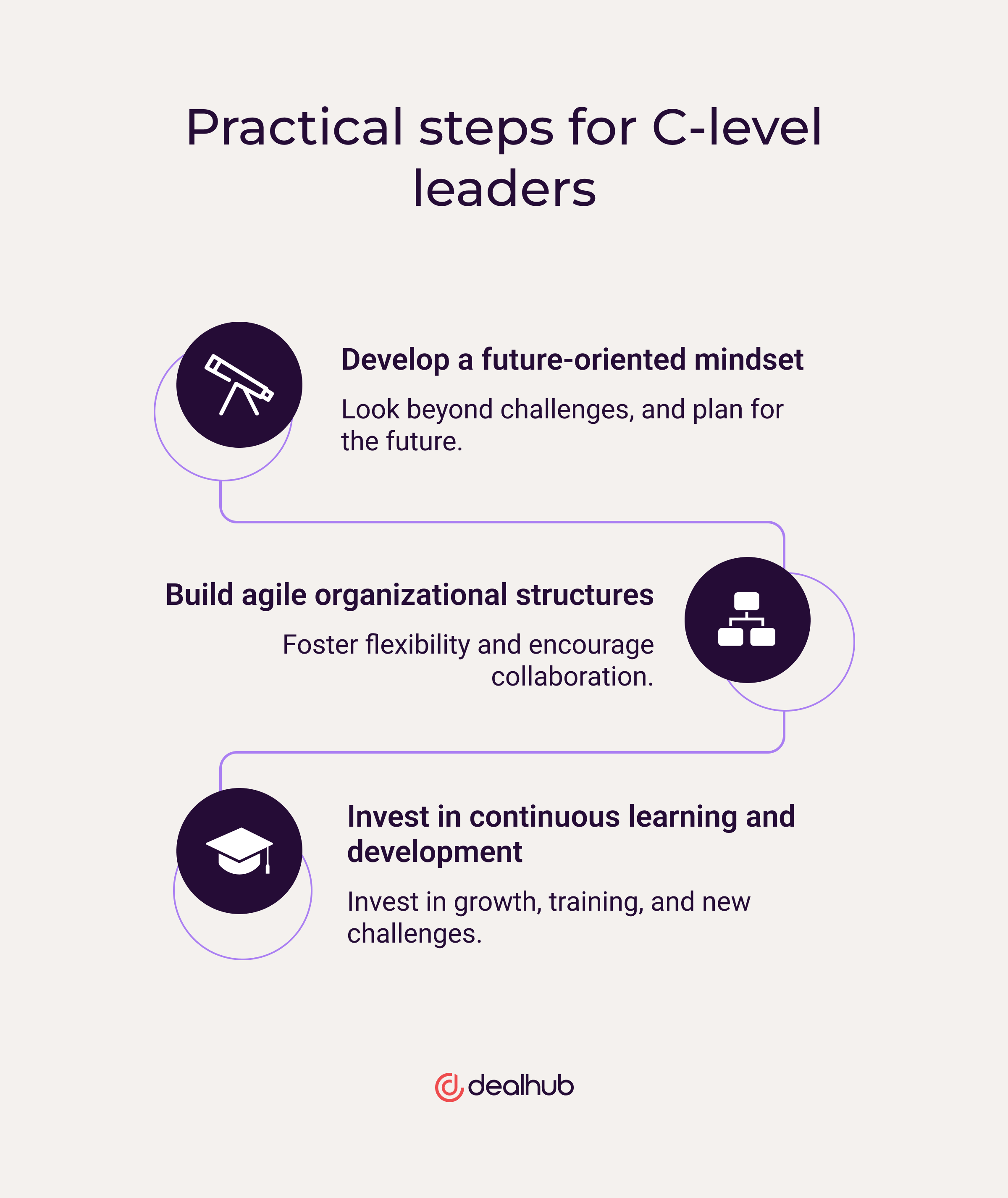To help counter this trend, we’re taking this opportunity to expand on Gartner’s prescription for the role of C-level executives in steering their organizations toward sustained success in an unpredictable business climate. Below we explore how executives can drive business value, embrace emerging technologies, and adopt a people-centric approach.
Strategies for driving business value
Recently, there has been a significant change in the definition of business value. Traditionally focused on financial metrics, today’s business value encompasses a broader spectrum, including societal impact, customer satisfaction, and innovation. Functional leaders are increasingly transitioning into business leaders, aligning their departmental objectives with the broader commercial goals of the organization. This shift is about embracing a holistic view of the organization’s impact on all stakeholders.
Keeping that in mind, here are some strategies for the C-suite to drive sustainable business value:
Aligning goals with societal and environmental impact
Businesses are no longer islands but part of a larger ecosystem. C-suite leaders recognize the importance of aligning business goals with societal and environmental considerations. This strategy is ethically sound and aligns with the growing consumer and employee demand for responsible corporate behavior. Companies that adopt sustainable practices and contribute positively to society tend to enjoy enhanced brand loyalty and reputation, which in turn drives business value.
Protecting and growing revenue
At the core of driving business value is the ability to protect and grow revenue. To succeed in business, it’s important to have a thorough understanding of market trends, customer requirements, and the competitive environment. By focusing on innovation, customer experience, and operational efficiency, C-suite executives can identify new revenue streams while safeguarding existing ones. This approach ensures a steady growth trajectory and a resilient business model capable of withstanding market fluctuations.
Leveraging data analytics for informed decision-making
In the age of big data, leveraging analytics for decision-making is paramount. Data-driven strategies allow leaders to understand customer behavior, predict market trends, and optimize operations. By integrating data analytics into their decision-making process, C-suite executives can make informed choices that drive efficiency, innovation, and business value.
Creating a customer-centric approach
A customer-centric approach involves understanding and anticipating customer needs and preferences to deliver personalized experiences. Companies can foster loyalty, improve retention, and attract new clients by prioritizing customer satisfaction. The C-suite is crucial in embedding a customer-first culture throughout the organization, ensuring that every decision contributes to a positive customer experience.
While redefining business value lays the foundation for sustainable growth, the strategic use of emerging technologies accelerates this growth.
How the C-suite is embracing emerging technologies

To enhance operational efficiency and customer experiences, C-suite leaders are not just adopting but strategically integrating emerging technologies into their organizations’ fabric. For CIOs and their peers, this means going beyond mere investment to fostering an environment where technology drives real business transformation. Examples of innovation include:
- Artificial Intelligence (AI) and machine learning: Leaders are embedding AI in strategic areas to streamline operations and glean insights that inform future strategies. For example, in the financial sector, AI is being used to predict market trends and personalize customer services, while in manufacturing, it’s optimizing supply chains and predictive maintenance.
- Cloud computing: C-suite executives are leveraging cloud computing for its scalability and efficiency, ensuring that their teams can collaborate and access necessary tools anywhere, anytime. This shift is particularly evident in the rapid adoption of cloud services for remote work environments and global operations.
- Blockchain and decentralized technologies: Forward-thinking leaders are exploring blockchain for its potential to enhance transparency and security, particularly in sectors like finance and supply chain management. They’re piloting projects to understand how smart contracts and decentralized ledgers can reduce fraud, streamline processes, and foster trust.
- Internet of Things (IoT): In industries from retail to healthcare, leaders are deploying IoT to get real-time insights and improve customer interactions. Whether it’s through smart inventory management systems or patient monitoring devices, IoT is becoming integral to driving efficiency and enhancing services.
Balancing innovation with risk management
While embracing these technologies can bring significant advantages, it also introduces new risks and challenges. C-suite leaders must, therefore, balance innovation with prudent risk management and data governance. This involves understanding the implications of new technologies, ensuring robust cybersecurity measures, and fostering a culture of continuous learning and adaptation. By doing so, they can harness the power of emerging technologies and safeguard their organization against potential pitfalls, steering their companies toward a future of growth and innovation.
As organizations embrace technological innovations, the role of people-centric leadership becomes even more critical. Technology, after all, is a tool in the hands of people. By fostering a culture that values every team member’s contribution and well-being, leaders can unlock the full potential of their technological investments, ensuring that these advancements lead to real and sustainable growth.
People-centered leadership
Adopting a human-centered approach in leadership is more than a moral imperative; it’s a strategic one. Leaders who prioritize the well-being and development of their people foster an environment of trust, creativity, and commitment. This approach leads to higher employee engagement and retention, which is a significant driver of organizational success. Engaged employees are more productive, provide better service, and are less likely to leave, reducing turnover costs and retaining valuable institutional knowledge.
Fostering a positive organizational culture
A positive organizational culture is the foundation of a people-first approach. This culture should extend beyond the immediate staff to include vendors and partners, creating an ecosystem where everyone feels valued and respected. A positive culture encourages open communication, feedback, and continuous improvement, contributing to a more resilient and adaptive organization.
Embracing diversity, equity, and inclusion
Diversity, equity, and inclusion are essential elements of effective leadership, not mere buzzwords. Implementing DEI initiatives leads to a richer variety of perspectives, ideas, and solutions, driving innovation and better decision-making. An inclusive environment where everyone is valued and empowered can significantly enhance collaboration and morale.
Promoting work-life balance
A corporate culture that promotes work-life balance is key to maintaining a healthy, productive workforce. Leaders must promote policies and practices that allow employees to effectively manage their professional and personal responsibilities. This might include flexible working hours, remote work options, and mental health and well-being support.
Growing talent from within
Investing in the development and growth of existing talent ensures a strong leadership pipeline, ready to meet future challenges. By providing opportunities for continuous learning and career advancement, leaders can improve their workforce’s skills and capabilities and increase loyalty and motivation.
Leading for resilience and growth
The volatility of our current business climate demands that resilience and growth be treated as imperatives, not just desired outcomes. Holistic leadership connects the dots between driving business value, embracing technology, and fostering a people-centered culture. This integrative approach ensures that organizations are not just surviving disruptions but are also positioned for growth.
Holistic leadership in action
Companies like Apple and Microsoft have exemplified resilience by continually innovating and adapting their strategies. Apple’s commitment to user-centric design and constant innovation has kept it at the forefront of technology and consumer products. Microsoft’s shift towards cloud computing and enterprise services under Satya Nadella’s leadership transformed the company, making it more agile and competitive.
Beyond the tech giants like Apple and Microsoft, companies across various sectors are exemplifying holistic leadership. For instance, Patagonia has set a benchmark for integrating environmental impact into business value in retail. At the same time, Salesforce has been a pioneer in leveraging cloud technology for growth. In the healthcare sector, companies like Mayo Clinic have used technology to improve patient care, demonstrating that resilience and innovation are not confined to any single industry. These diverse examples illustrate that regardless of the industry, embracing a comprehensive approach to leadership helps organizations thrive.
Practical steps for C-level leaders

To implement these themes, consider the following enhanced strategies:
- Developing a future-oriented mindset: Corporate leaders must look beyond immediate challenges and plan for the future. This involves understanding emerging trends, anticipating market shifts, and preparing the organization to adapt quickly. Executives should regularly conduct scenario planning sessions to envision various future market conditions and develop flexible strategies accordingly.
- Building agile and adaptable organizational structures: Agility and resilience go hand-in-hand. Executives should foster a culture of flexibility, where teams can pivot quickly in response to changes. This might involve flattening hierarchies, encouraging cross-functional collaboration, and reducing bureaucracy.
- Investing in continuous learning and development: To stay ahead of the curve, organizations must invest in their people’s growth. This includes providing training in new technologies, leadership development programs, and opportunities for employees to take on new challenges. Leaders could also create personalized learning paths for employees that align with emerging business needs and technological advancements.
These strategies must be tailored to the specific context and culture of the organization, as well as the external market conditions. By doing so, C-level executives can ensure that their organizations are not just prepared to face the current challenges but are also equipped to seize future opportunities.









